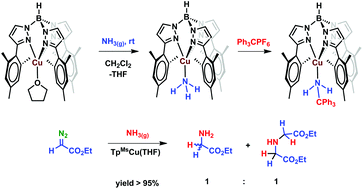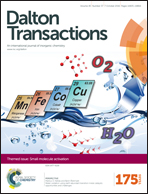Copper-induced ammonia N–H functionalization†
Abstract
The activation of ammonia has been achieved with the aid of the TpMsCu core (TpMs = hydrotris(3-mesityl-pyrazolyl)borate). Complexes of the general composition TpMsCu(amine) (1–4) including the ammonia adduct TpMsCu(NH3) (1) have been synthesized and fully spectroscopical- and structurally characterized. Coordinated ammonia in 1 has been reacted with Ph3CPF6 yielding TpMsCu(NH2CPh3) (5) as a result of N–H cleavage and N–C bond formation. In a parallel manner the catalytic functionalization of ammonia with ethyl diazoacetate leading to glycinate derivatives has been developed with TpMsCu(THF) as the catalyst, in the first example of this transformation with ammonia and a copper-based system.

- This article is part of the themed collection: Small Molecule Activation

 Please wait while we load your content...
Please wait while we load your content...